Introduction
This presentation is developed to review the evidence on the topic of income inequality and answer the following question: are the rich getting richer? The question is considered by Bennett, Briggs, and Triola (2017), and their book is the primary source of the present analysis. Two news articles by Ingraham (2018) and Porter and Russell (2017) are reviewed as well. The data from the three sources are used to test the thesis proposed by Bennett et al. (2017); the authors suggest that the rich are getting richer, but it is not a purely negative event.
Key Notions
Bennett et al. (2017) introduce three key notions that are going to be used in this analysis. First, they review the Gini index, which was developed specifically to measure income inequality. In it, 0 refers to perfect equality, and 1 to perfect inequality; the latter is the situation in which all the income is concentrated in the hands of one person. Quintile analysis is another form of income statistics that divides the population into five parts depending on their income. The third concept is the Pareto criterion; Bennett et al. (2017) use it to assess changes. According to this criterion, only a change that does not result in negative developments for anyone involved is positive. Finally, the present analysis will also consider the mean, median, and mode. The mode is the most frequently occurring score in a distribution; the median is the central one, and the mean refers to the “average score of the distribution” (Healey, 2015, p. 73).
Important Statistics
Figure 1 presents the mean and median income in the US and its changes during 1975-2016. The figure shows an unsteady increase, which can be viewed as a positive trend and is also reported by Bennett et al. (2017). The review of the actual distribution of household income for one year may provide more data. In Figure 2, the mode (the most commonly encountered income) is marked as $12,300 while the income approximating $206,600 and more is also present. Thus, this figure shows the inequality in the distribution of income, but it cannot measure it or show its dynamics.
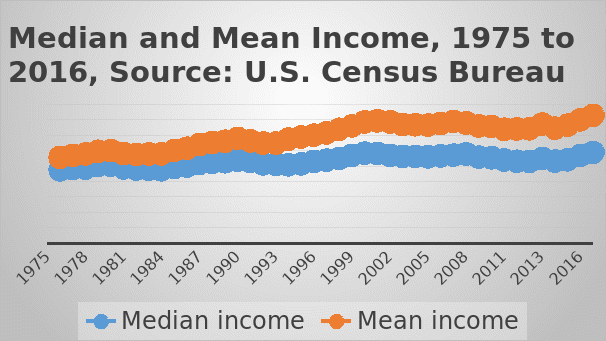
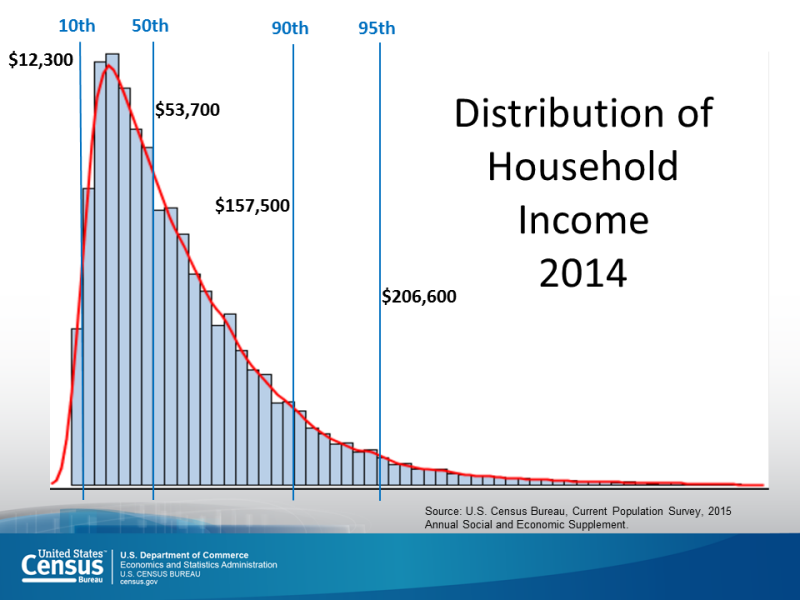
Important Statistics from the Articles
To measure income inequality, the Gini index can be used. In Figure 3, Gini indicates that inequality in the US has been rising over the past few decades. However, as pointed out by Bennett et al. (2017), this index cannot prove that the rich become richer.
The analysis of the articles by Porter and Russell (2017) and Ingraham (2018) can produce some additional data on the topic. As can be seen from Figure 4, the share of global income that is attributed to its top 1 percent is greater than that received by the bottom 50%. The figure also captures a notable decrease in the share of the richest 1%, which happened after the crisis of 2008. A similar situation is demonstrated in Figure 5: a small decrease in the income and wealth of the 1% can be seen by the end of the presented period. Both figures illustrate the overall trend of increase in the wealth and income of the richest 1%, but they also suggest that the share of the richest people in the global income and wealth is decreasing. However, this tendency does not illustrate the changes in the income of the rich; it focuses on their share. In the end, the two figures support the idea of income inequality.
To check the increase in the income of the rich, quintile analysis should be used. Figure 6 shows that over the years, the highest quintile is only one that has experienced steady growth in household income. A minor decrease in that of the top 5% can also be noted to illustrate the above-found tendencies, but the figure still proves the idea that the rich are getting richer.
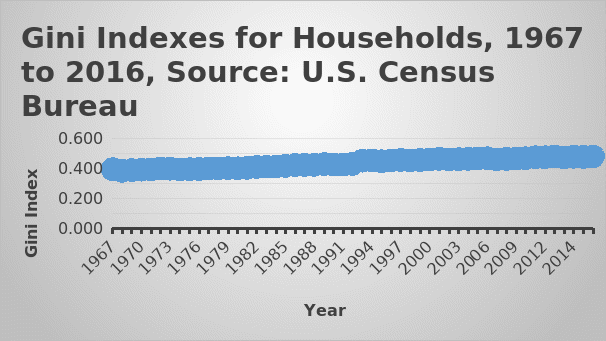
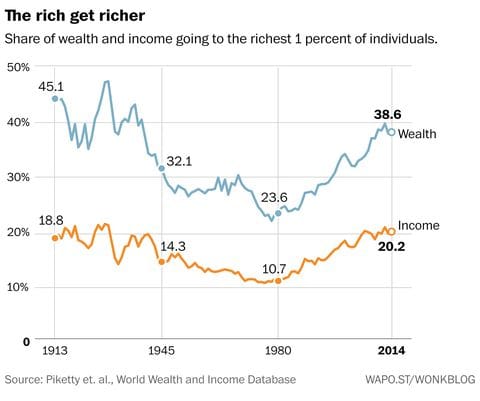
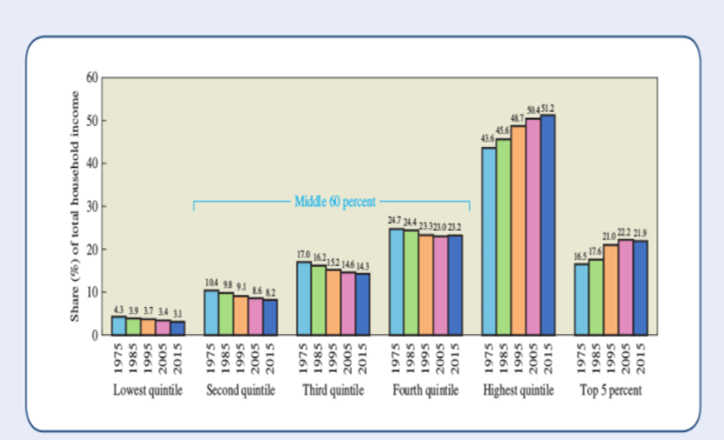
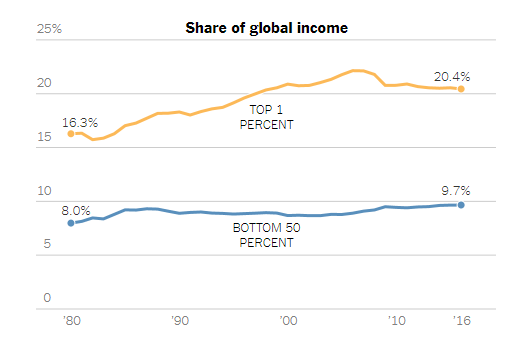
Conclusions: Are the Rich Getting Richer?
Having reviewed the data, the presentation can reconsider its question and assess the thesis of Bennett et al. (2017). In the fourth article, Bennett et al. (2017) prove the idea that the rich become richer, but they also suggest that the situation is not as problematic as it is typically portrayed because of the Pareto criterion. The presented analysis included statistics from several sources, which can be used to show that the first part of the thesis is supported.
The review of the median and mean shows that the income in the US has been increasing, and the inequality has been rising too as can be seen from the Gini index changes and those registered by the quintile analysis. The consideration of the changes in the wealth and income shares of the top 1% shows notable global inequality, and the mode considerations prove it for the US. Furthermore, the quintile analysis confirms the fact that the rich become richer. Thus, this part of the thesis of Bennett et al. (2017) is supported.
The question of whether it is a problem or not is less easy to consider. Bennett et al. (2017) use the Pareto criterion, which, according to them, suggests that “any change is good if it makes someone better off without making anyone else worse off” (p. 158). However, when applying the criterion, Bennett et al. (2017) state that “few people have been harmed by the rise of inequality” (p. 158). Since some people are hurt, the Pareto criterion as defined by Bennett et al. (2017) does not fit the situation. Furthermore, the definition of Bennett et al. (2017) is correct and supported by other articles (Ventura et al., 2016). Therefore, according to the Pareto criterion, the situation might be not viewed as a positive one. This idea is also supported by Porter and Russell (2017), who suggest the ways to reduce inequality, and Ingraham (2018), who focuses on its negative outcomes. In summary, while it can indeed be assumed that the current changes in the income and wealth of the rich and poor are not unambiguously negative, the Pareto criterion might be not applicable to it.
References
Bennett, J., Briggs, W., & Triola, M. (2017). Statistical reasoning for every day life (5th ed.). New York, NY: Pearson.
Healey, J. (2015). Statistics. New York, NY: Cengage Learning.
Ingraham, C. (2018). How rising inequality hurts everyone, even the rich. The Washington Post. Web.
Porter, E., & Russell, K. (2017). It’s an unequal world. It doesn’t have to be. The New York Times. Web.
U.S. Census Bureau. (2015). Distribution of household income 2014.
U.S. Census Bureau. (2017). Historical income tables: Households.
Ventura, A., Cafiero, C., & Montibeller, M. (2016). Pareto efficiency, the Coase theorem, and externalities: A critical view. Journal Of Economic Issues, 50(3), 872-895.
World Wealth and Income Database. World inequality report 2018. Web.